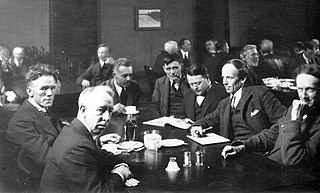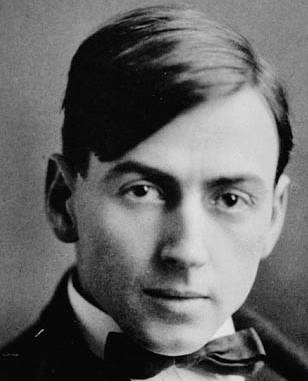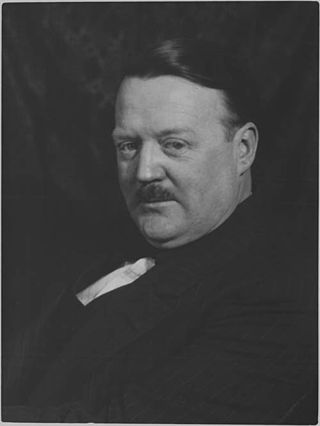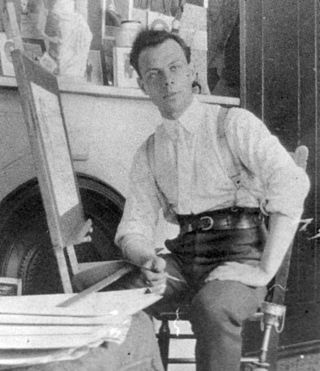
The Group of Seven, once known as the Algonquin School, was a group of Canadian landscape painters from 1920 to 1933, with "a like vision". It originally consisted of Franklin Carmichael (1890–1945), Lawren Harris (1885–1970), A. Y. Jackson (1882–1974), Frank Johnston (1888–1949), Arthur Lismer (1885–1969), J. E. H. MacDonald (1873–1932), and Frederick Varley (1881–1969). A. J. Casson (1898–1992) was invited to join in 1926, Edwin Holgate (1892–1977) became a member in 1930, and Lionel LeMoine FitzGerald (1890–1956) joined in 1932.

The Beaver Hall Group refers to a Montreal-based group of Canadian painters who met in the late 1910s while studying art at a school run by the Art Association of Montreal. The Group is notable for its equal inclusion of men and women artists, as well as for its embrace of Jazz Age modernism. They painted a variety of subjects, including portraits, landscapes, urban scenes and still lifes, in a mix of Modernist and traditional styles.

Thomas John Thomson was a Canadian artist active in the early 20th century. During his short career, he produced roughly 400 oil sketches on small wood panels and approximately 50 larger works on canvas. His works consist almost entirely of landscapes, depicting trees, skies, lakes, and rivers. He used broad brush strokes and a liberal application of paint to capture the beauty and colour of the Ontario landscape. Thomson is considered by many Canadians as the archetypal painter, and his later work has heavily influenced Canadian art – paintings such as The Jack Pine and The West Wind have taken a prominent place in the culture of Canada and are some of the country's most iconic works. His accidental death by drowning at 39 shortly before the founding of the Group of Seven is seen as a tragedy for Canadian art.

Arthur Lismer, LL.D. was an English-Canadian painter, member of the Group of Seven and educator. He is known primarily as a landscape painter and for his paintings of ships in dazzle camouflage.

Alexander Young Jackson LL. D. was a Canadian painter and a founding member of the Group of Seven. Jackson made a significant contribution to the development of art in Canada, and was instrumental in bringing together the artists of Montreal and Toronto. In addition to his work with the Group of Seven, his long career included serving as a war artist during World War I (1917–19) and teaching at the Banff School of Fine Arts, from 1943 to 1949. In his later years he was artist-in-residence at the McMichael Canadian Art Collection in Kleinburg, Ontario.

Homer Ransford Watson was a Canadian landscape painter. He has been characterized as the painter who first painted Canada as Canada, rather than as a pastiche of European painting. He was a member and president (1918–1922) of the Royal Canadian Academy of Arts, as well as a founding member and first president (1907–1911) of the Canadian Art Club. Although Watson had almost no formal training, by the mid-1920s he was well known and admired by Canadian collectors and critics, his rural landscape paintings making him one of the central figures in Canadian art from the 1880s until the First World War.

Frederick Horsman Varley was a member of the Canadian Group of Seven.

Lawren Stewart Harris LL. D. was a Canadian painter, best known as one of the founding members of the Group of Seven. He played a key role as a catalyst in Canadian art, as a visionary in Canadian landscape art and in the development of modern art in Canada.

The Algoma Central Railway is a railway in Northern Ontario, Canada, that operates between Sault Ste. Marie and Hearst. It used to have a branch line to Wawa. The area served by the railway is sparsely populated, with few roads.

Franklin Carmichael was a Canadian artist and member of the Group of Seven. Though he was primarily famous for his use of watercolours, he also used oil paints, charcoal and other media to capture the Ontario landscapes. Besides his work as a painter, he worked as a designer and illustrator, creating promotional brochures, advertisements in newspapers and magazines, and designing books. Near the end of his life, Carmichael taught in the Graphic Design and Commercial Art Department at the Ontario College of Art.

Francis Hans Johnston was a member of the Group of Seven. He most commonly worked as a landscape painter though in a more conservative mode than other members of the Group. He also used tempera rather than oil paint in his Algoma landscapes, a fast-drying material that was more often associated with commercial art of his day.
Caroline Leaf is a Canadian-American filmmaker, animator, director, tutor and artist. She has produced numerous short animated films and her work has been recognized worldwide. She is best known as one of the pioneering filmmakers at the National Film Board of Canada (NFB). She worked at the NFB from 1972 to 1991. During that time, she created the sand animation and paint-on-glass animation techniques. She also tried new hands-on techniques with 70mm IMAX film. Her work is often representational of Canadian culture and is narrative-based. Leaf now lives in London, England, and is a tutor at The National Film and Television School. She maintains a studio in London working in oils and on paper and does landscape drawing with an iPad.

The McMichael Canadian Art Collection (MCAC) is an art museum in Kleinburg, Ontario, Canada. The museum is located on a 40-hectare (100-acre) property in Kleinburg, an unincorporated village in Vaughan. The property includes the museum's 7,900-square-metre (85,000 sq ft) main building, a sculpture garden, walking trails, and a cemetery for six members of the Group of Seven.

Alfred Joseph Casson was a member of the Canadian group of artists known as the Group of Seven. He joined the group in 1926 at the invitation of Franklin Carmichael, replacing Frank Johnston. Casson is best known for his depictions in his signature limited palette of southern Ontario, and for being the youngest member of the Group of Seven.

David Milne was a Canadian painter, printmaker, and writer. He was profoundly different from most of his Canadian art contemporaries, especially Tom Thomson and the Group of Seven. He is sometimes referred to as the Master of Absence and known for his ability to reduce a painting to its bare essentials.

Canadian art refers to the visual as well as plastic arts originating from the geographical area of contemporary Canada. Art in Canada is marked by thousands of years of habitation by Indigenous peoples followed by waves of immigration which included artists of European origins and subsequently by artists with heritage from countries all around the world. The nature of Canadian art reflects these diverse origins, as artists have taken their traditions and adapted these influences to reflect the reality of their lives in Canada.

The Maplewood Flats Conservation Area is a 126 hectare conservation area located in North Vancouver, British Columbia, Canada. The area is composed of a 96 hectare intertidal zone of mudflats and salt marsh, and a 30 hectare upland area. It is preserved by Port Metro Vancouver as one of their ecological land initiatives. The land is located approximately 2 km east of the Second Narrows Bridge along Burrard Inlet in North Vancouver.

Gary and Joanie McGuffin are Canadian explorers, conservation photographers, writers, motivational speakers, documentarians and conservationists. Their most documented adventures have been about canoeing on waterways throughout North America, bicycling from the Arctic to the Pacific to the Atlantic oceans, backpacking the entire length of the Appalachian Trail, circumnavigating Lake Superior by canoe and paddling across Northern Ontario in the footsteps of Grey Owl. The McGuffins are noted primarily for their popular paddle sports instructional books on canoeing and kayaking, and their documentary film based on their research about the Group of Seven artists. Between adventures, the McGuffins are ambassadors of the wilderness, touring the world through speaking events, photo exhibitions, book tours, eco-tourism development, and educational seminars on conservation. In 2000, the Ontario government officially appointed Gary and Joanie as Champions of the Coast under the Great Lakes Heritage Coast program. In 2003, they were the recipients of the Premier's Award and the Queen's Golden Jubilee Medal for wilderness preservation and environmental education achievements for their province and their country.

The Canadian painter Tom Thomson died on 8 July 1917, on Canoe Lake in Algonquin Provincial Park in Nipissing District, Ontario, Canada. After Thomson drowned in the water, his upturned canoe was discovered later that afternoon and his body eight days later. Many theories regarding Thomson's death—including that he was murdered or committed suicide—have become popular in the years since his death, though these ideas lack any substantiation.

Tom Thomson (1877–1917) was a Canadian painter from the beginning of the 20th century. Beginning from humble roots, his development as a career painter was meteoric, only pursuing it seriously in the final years of his life. He became one of the foremost figures in Canadian art, leaving behind around 400 small oil sketches and around fifty larger works on canvas.
















